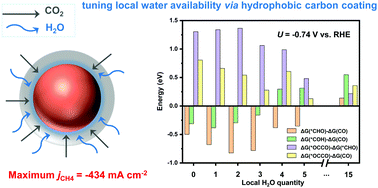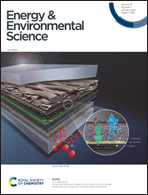Selective methane electrosynthesis enabled by a hydrophobic carbon coated copper core–shell architecture†
Abstract
The electrosynthesis of valuable chemicals via carbon dioxide reduction reaction (CO2RR) has provided a promising way to address global energy and sustainability problems. However, the selectivity and activity of deep-reduction products (DRPs) still remain as big challenges. Here, a copper–carbon-based catalyst with a hydrophobic core–shell architecture has been constructed and was found to exhibit excellent DRPs of methane generation with a faradaic efficiency of 81 ± 3% in a neutral medium and a maximum partial current density of −434 mA cm−2 in a flow cell configuration, which is among the best of CO2-to-CH4 electrocatalysts. Density functional theory calculations suggest that the hydrophobic structure decreasing the water coverage on the catalyst surface can promote the protonation of the *CO intermediate and block CO production, further favoring the generation of methane. These results provide a new insight into the electrosynthesis of DRPs via constructing a hydrophobic core–shell architecture for tuning the surface water coverage.



 Please wait while we load your content...
Please wait while we load your content...